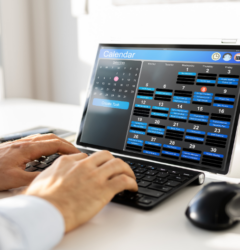- Email: [email protected]
- phone: +44 (0) 203 916 5117
18 Jun

In the fast-paced world of conferences, webinars, and client meetings, attendance and engagement are everything. Traditional email invitations often fall short in delivering these results. They get lost in inbox clutter, buried in spam folders, or simply ignored.
Enter the calendar invitation—a tool that lives where your attendees live: their calendars. With just one click, an event gets added to a user's schedule, with reminders, timezone syncing, and more. It's persistent, discreet, and far more effective.
With tools like Let’s Calendar, you can now send personalized, discreet, and bulk calendar invites to 10,000+ people instantly—across platforms like Gmail, Outlook, and Apple Calendar. This blog will explore why calendar invites are far superior to email invites and how to implement them efficiently at scale.
Email Invitations vs. Calendar Invites: Why Timing and Location Matter
A traditional email invitation is just that—an email. It may or may not be opened. Even if read, it can be forgotten. A calendar invite, however, stays put in the attendee's schedule, with auto-reminders and visibility across all their devices.
Unlike email, a calendar entry:
- Triggers automatic reminders
- Adjusts to time zones
- Can include clickable links, directions, or seat numbers
When combined with real-time RSVP tracking, calendar invites become a powerful operational tool—not just a passive reminder.
What Is a Calendar Invite?
A calendar invitation is a scheduled event entry sent directly to a user's calendar platform (Google, Apple, Outlook, etc.). It can include:
- Event title & description
- Location or meeting link
- Start/end times
- Reminders and alerts
Used properly, calendar invites are event engagement assets that sit directly within an attendee's daily workflow.
Why Bulk Calendar Invites Work Better
1. Persistent Visibility
While emails get archived or deleted, calendar invites remain visible right up to the event. Attendees receive pre-set reminders based on their preferences.
2. 1:1 Personalization at Scale
With Let’s Calendar, you can tailor each invite with personalized:
- Session info
- Virtual links (Zoom, Meet, Teams)
- Personalized agendas or seat assignments
This is critical for large-scale B2B or CXO meetings.
3. Discreet & Private
Unlike mass CC/BCC emails, Let’s Calendar allows discreet 1:1 delivery—no visibility of other invitees.
Why Let's Calendar Is a Game-Changer
Let’s Calendar helps event organizers:
- Send calendar invites to 10 to 100,000 recipients
- Track RSVPs and engagement in real-time
- Work seamlessly with Gmail, Outlook, and Apple Calendar
- Avoid inbox overload while enhancing deliverability
It also supports bulk personalization via CSV uploads, CRM syncs, and Zapier workflows.
Step-by-Step: Sending Bulk Calendar Invites via Let’s Calendar
Step 1: Create Event
Define your event title, description, date/time, location, and virtual link.
Step 2: Upload Your Attendee List
Upload a CSV with email, name, and personalization fields (e.g., link, seat, session track).
Step 3: Personalize Each Invite
Use merge fields like:
- "Hi [Name]"
- Personalized Zoom/Meet links
- Session breakout info
Step 4: Send Across Platforms
Let’s Calendar detects the attendee's email domain and serves them a platform-specific invite:
- Google: Send calendar invite Gmail (works with G Suite, Gmail, Google Workspace)
- Microsoft: Calendar invites Outlook, O365-compatible format
- Apple: iCal and Wallet-compatible
Step 5: Enable “Add to Calendar” Buttons
Insert a universal “add calendar to event” button in your emails, landing pages, and confirmation messages.
Add to Calendar Across Major Platforms
Let’s Calendar ensures compatibility across:
- Google Calendar – direct .ics or link format
- Outlook Calendar – supports calendar invite on Outlook through exchange integration
- Apple Calendar – supports iCal and Wallet pass addition
Its “Add to Calendar” features are compliant with all formats, allowing for easy RSVP logging.
Outlook vs Gmail: Platform Specific Tips
For Outlook
- Format invites to comply with calendar invitation Outlook best practices
- Avoid formatting issues by using pre-tested templates
- Consider guest visibility and Exchange permissions
For Gmail
- Use structured metadata for send meeting invite in Gmail with .ics fallback
- Compatible with both web and mobile Gmail apps
- RSVP tracking enabled through Let’s Calendar links
Case Study: CXO Webinar Success
A fintech company used Let’s Calendar to send calendar invites to 18,000 attendees. Each CXO received a personalized link, entry QR code, and VIP access note. The result? A 58% attendance rate (vs 31% industry average for email-only invitations).
Best Practices for Using Bulk Calendar Invitations
- Always include fallback .ics files
- Add timezone-friendly slots
- Use “Add to Calendar” on all confirmation pages
- Track delivery and open rates using Let’s Calendar dashboard
Conclusion: Why It’s Time to Move Beyond Email Invites
While traditional emails still play a role in outreach, they are no longer effective as the sole method of driving attendance. A calendar invitation is embedded in the attendee's workflow—it’s visual, persistent, and actionable.
Tools like Let’s Calendar make it possible to send calendar invites Outlook, Gmail, and Apple users with full personalization, RSVP tracking, and automation. The result? Less no-show, better preparedness, and measurable success.
Schedule your next webinar, conference, or meeting like a pro. Send personalized calendar invites in bulk, with reminders, tracking, and multi-platform support.









Recent Comments